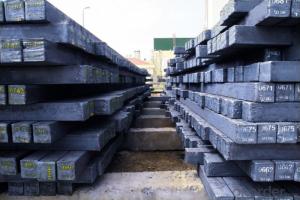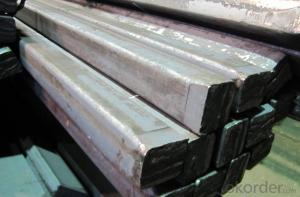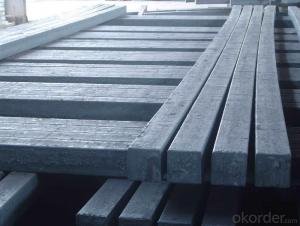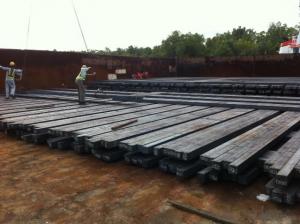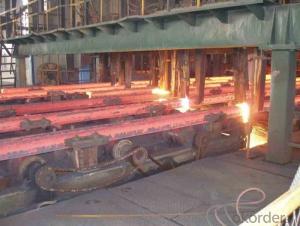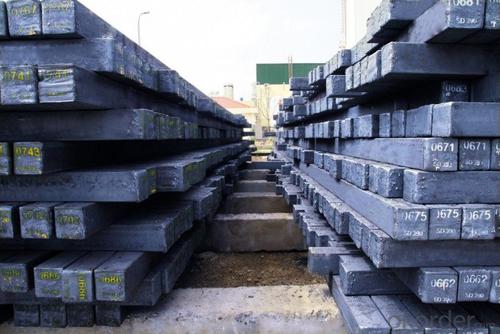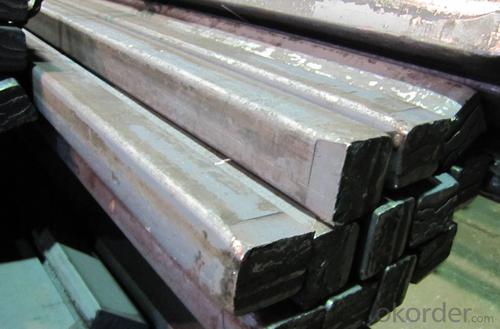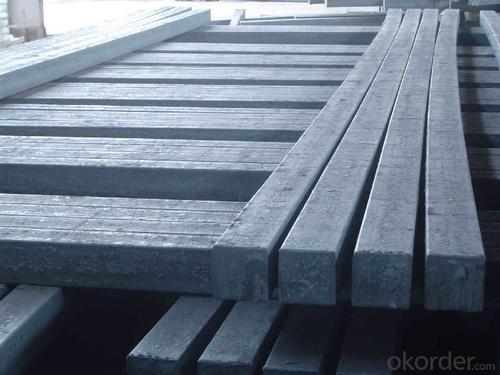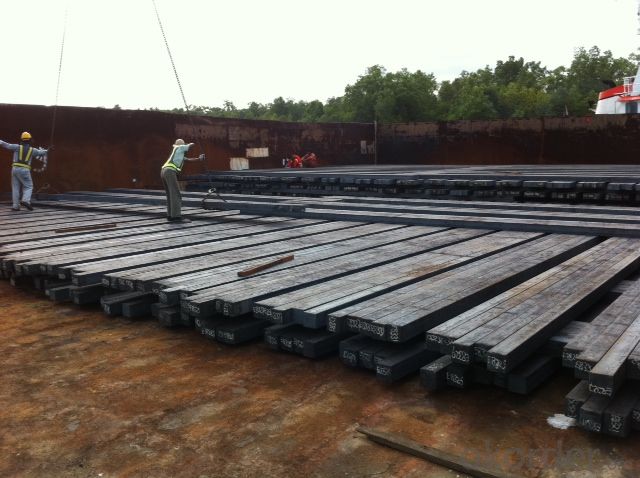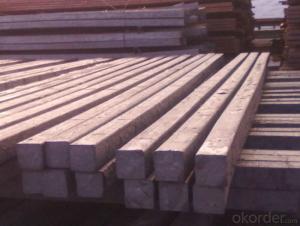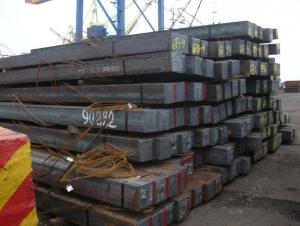Square Steel Billet Q235 3SP Grade Prime Quality 6#
- Loading Port:
- Tianjin
- Payment Terms:
- TT OR LC
- Min Order Qty:
- 2000 m.t
- Supply Capability:
- 50000 m.t/month
OKorder Service Pledge
OKorder Financial Service
You Might Also Like
Description of Square Steel Billet Q235 3SP Grade Prime Quality 6#
M. S. Billets are used for rolling of TMT Re-Bars of Fe415 and Fe500 Grade and various other structural steel products.
CRS Billets are used for rolling of CRS TMT Re-Bars.
Special Alloy Billets are used for rolling of any special grade TMT Re-Bars like Earthquake resistant TMT Re-Bars and for special grade structural steel products.
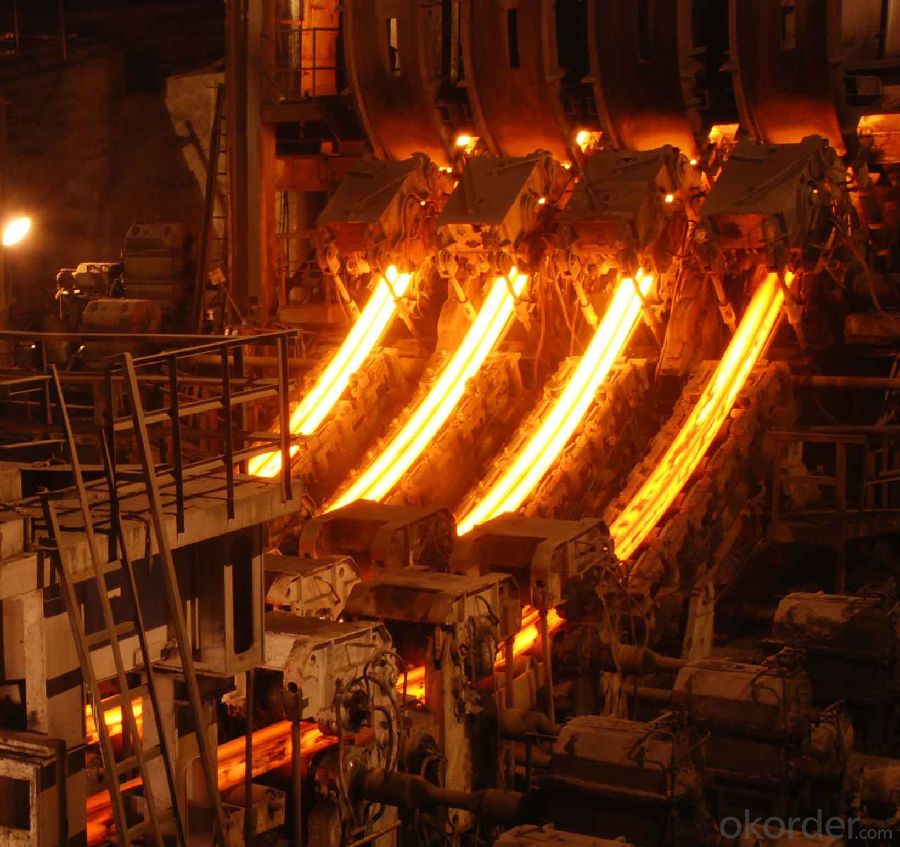
Main Feature Square Steel Billet Q235 3SP Grade Prime Quality 6#
Raw elements(C,Fe,Ni,Mn,Cr,Cu.)---Smelted ingots by AOD finery---hot rolled into black suface---pickling in acid liquid---cold drawn----polished by automatically machine--- cutting into pieces---checking quanlity
Applications of Square Steel Billet Q235 3SP Grade Prime Quality 6#
Widely Used in the areas such as Stainless Steel Fasteners, Chains, Kitchen and Sanitary wares, Furniture handles, Handrails, Electroplating and Electrolyzing pendants, Foods, Electron, Petroleum, Construction and Decoration, etc. Products have a high strength after cold-working. Electronic products parts, Medical appliance, Springs, Bus Inside and Outside packaging and building, Street Lamp Posts, etc. Decoration materials and Outdoor Publicity Billboard. Used for the products which have the Anti-Stress Corrosion requirement. Electron Products, Table-wares, Bolts, Nuts, Screen Meshes, Cumbustors and so on.
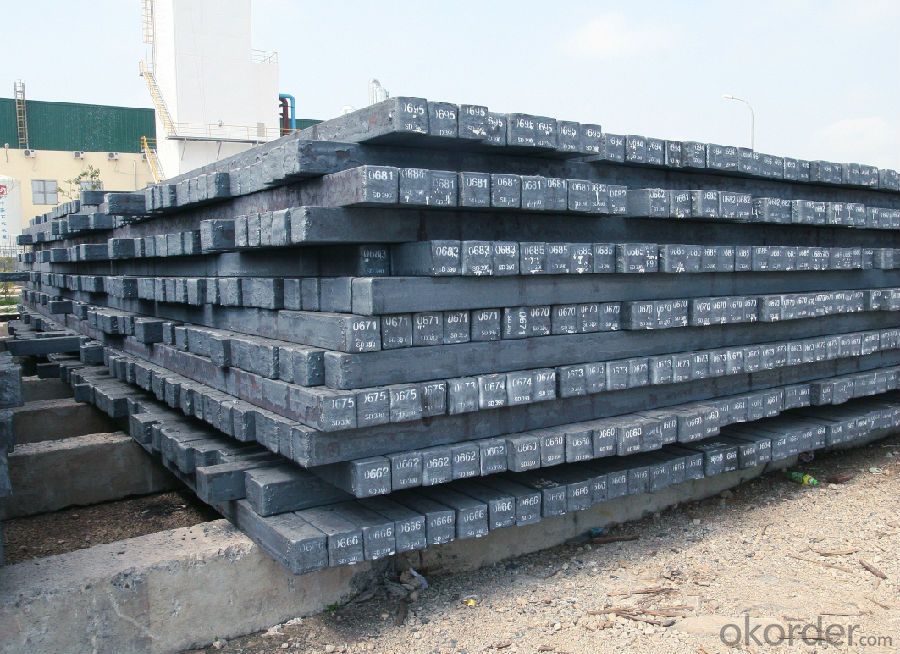
Specifications of Square Steel Billet Q235 3SP Grade Prime Quality 6#
| Standard | C(%) | Mn(%) | S(%) | P(%) | Si(%) |
| Q195 | ≤0.12 | ≤0.50 | ≤0.040 | ≤0.035 | ≤0.30 |
| Q235 | ≤0.20 | ≤1.40 | ≤0.045 | ≤0.045 | ≤0.35 |
| Q275 | ≤0.22 | ≤1.50 | ≤0.045 | ≤0.045 | ≤0.35 |
| 20MnSi | 0.17-0.25 | 1.2-1.6 | ≤ 0.050 | ≤ 0.050 | 0.40-0.80 |
| 3SP | 0.14-0.22 | 0.40-0.85 | ≤ 0.050 | ≤ 0.040 | 0.05-0.15 |
| 5SP | 0.28-0.37 | 0.50-1.00 | ≤ 0.050 | ≤ 0.040 | 0.15-0.30 |
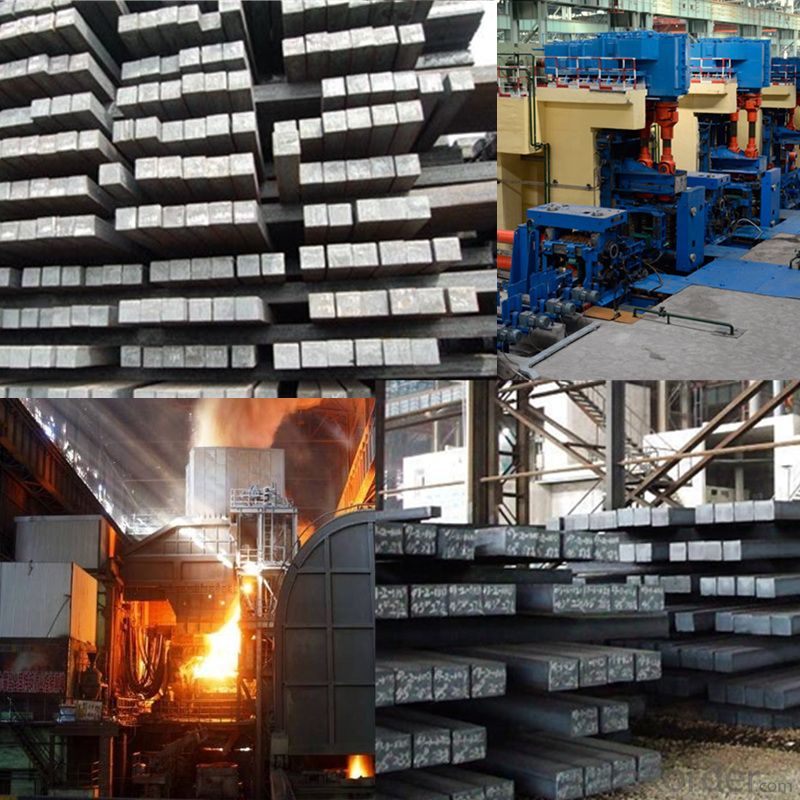
FAQ of Square Steel Billet Q235 3SP Grade Prime Quality 6#
We have organized several common questions for our clients,may help you sincerely:
1. How Can I Visit There?
Our company is located in Tianjin City, China, near Beijing. You can fly to Tianjin Airport Directly. All our clients, from home or aboard, are warmly welcome to visit us!
2. How Can I Get Some Sample?
We are honored to offer you sample.
3. Why choose CNBM?
Our delivery time about 15-20days for standard sizes, if you have other requirements like hardness, quanity and width ,it is about 20-40days. But don't worry we also try our best for the delivery time ,because time longer and our cost is higher.
- Q: What are the different methods of steel billet inspection?
- There are several different methods of steel billet inspection that are commonly used in the manufacturing industry. These methods are employed to ensure the quality and integrity of the steel billets before they are further processed into various end products. Some of the most common methods of steel billet inspection include: 1. Visual Inspection: This is the simplest and most basic method of inspection, where trained inspectors visually examine the billets for any surface defects, such as cracks, pits, or any other irregularities. This method is typically used as an initial screening process before more advanced inspection techniques are employed. 2. Ultrasonic Testing: Ultrasonic testing utilizes high-frequency sound waves to detect any internal defects or inconsistencies within the steel billets. This method involves the use of a transducer that emits sound waves into the billet, and the reflected waves are analyzed to identify any flaws or abnormalities. Ultrasonic testing is effective in detecting internal defects like voids, inclusions, or cracks. 3. Magnetic Particle Inspection: This method is particularly useful for detecting surface and near-surface defects in steel billets. It involves applying a magnetic field to the billet and then applying iron particles to the surface. The particles will cluster around any magnetic leakage caused by surface cracks or defects, making them easily visible to the inspector. 4. Eddy Current Testing: Eddy current testing is a non-destructive method used to detect surface and near-surface defects in conductive materials, including steel billets. It involves passing an alternating current through a coil, creating an electromagnetic field. Any changes in the electromagnetic field caused by defects in the billet's surface are detected and analyzed, allowing for the identification of flaws. 5. X-ray Inspection: X-ray inspection is a widely used method for inspecting steel billets. It involves passing X-rays through the billet and capturing the resulting image on a film or digital detector. This method is highly effective in detecting both internal and external defects, such as cracks, voids, inclusions, or segregation. These are just a few of the commonly employed methods of steel billet inspection. Each method has its advantages and limitations, and the choice of inspection technique depends on factors such as the type of defect being targeted, the size and shape of the billets, and the specific requirements of the end product. By utilizing a combination of these inspection methods, manufacturers can ensure the quality and reliability of the steel billets they produce.
- Q: What are the different shapes available for steel billets?
- Steel billets are commonly manufactured in various shapes to meet the diverse needs of different industries. Some of the different shapes available for steel billets include: 1. Square Billets: These are billets with equal sides, forming a square shape. Square billets are widely used in the construction industry for manufacturing beams, columns, and other structural components. 2. Round Billets: These billets have a circular cross-section and are commonly used in the production of seamless pipes, tubes, and rods. Round billets are also utilized in the automotive and aerospace industries for manufacturing various components. 3. Rectangular Billets: These billets have unequal sides, forming a rectangular shape. Rectangular billets are often utilized in the construction industry for manufacturing frames, window profiles, and other structural elements. 4. Hexagonal Billets: Hexagonal billets have six equal sides, forming a hexagon shape. These billets are commonly used in the production of bolts, nuts, and other fasteners that require a hexagonal shape for proper fitting. 5. Octagonal Billets: Octagonal billets have eight equal sides, forming an octagon shape. These billets are often used in the manufacturing of special components and tools that require a unique shape for specific applications. 6. Slab Billets: Slab billets have a rectangular cross-section with a larger width compared to their height. Slab billets are primarily used for producing flat-rolled steel products such as sheets, plates, and coils. 7. Bloom Billets: Bloom billets have a square or rectangular cross-section with a larger size compared to regular billets. These billets are commonly used in the production of sections, bars, and rails. The choice of the steel billet shape depends on the specific requirements of the desired end product and the manufacturing process involved. The versatility of steel billets makes them suitable for a wide range of applications in various industries.
- Q: Can steel billets be used in the production of energy-efficient appliances?
- Certainly, energy-efficient appliances can make use of steel billets. Steel, being a versatile material renowned for its strength and durability, is extensively employed in appliance manufacturing. These appliances are designed to minimize energy consumption and greenhouse gas emissions by employing less energy while performing their designated tasks. When it comes to energy-efficient appliances, steel billets can be processed and transformed into numerous components, including outer shells, structural supports, and internal parts. The incorporation of steel ensures the longevity and dependability of these appliances, thereby enhancing their overall energy efficiency. Moreover, steel is highly recyclable, allowing it to be repurposed or reused for other applications once an appliance reaches the end of its lifecycle. Steel recycling aids in energy conservation and waste reduction, further bolstering the pursuit of energy efficiency. To summarize, the utilization of steel billets is indeed feasible in the production of energy-efficient appliances. The exceptional properties of steel, namely its strength, durability, and recyclability, make it an ideal choice for manufacturing appliances that promote a more sustainable future.
- Q: How are steel billets formed into other shapes?
- Steel billets undergo a transformative process known as hot rolling or cold rolling to assume alternate shapes. During hot rolling, the steel billet is subjected to high temperatures and pressure as it passes through a succession of rollers to acquire the desired form. This technique is typically employed for larger and more intricate shapes like beams, channels, and angles. Conversely, cold rolling takes place at room temperature and involves guiding the steel billet through a series of rollers to gradually reduce its thickness and shape it into sheets, strips, or coils. Cold rolling is commonly utilized to fabricate thinner and more precise shapes such as plates, foils, and bars. In addition to rolling, steel billets can be transformed into diverse shapes through other processes such as forging, extrusion, and casting. Forging entails the application of pressure to the heated billet using a die or hammer, effectively shaping it into the desired form. Extrusion involves the passage of the heated billet through a die to create elongated and continuous shapes like pipes or tubes. Casting calls for the pouring of molten steel into a mold, allowing it to solidify into the desired shape. Collectively, the conversion of steel billets into alternative shapes necessitates a range of manufacturing processes including hot rolling, cold rolling, forging, extrusion, or casting, contingent upon the desired shape and properties of the final product. These processes guarantee the versatility of steel billets, enabling their transformation into a vast array of shapes suitable for various applications in construction, automotive, aerospace, and manufacturing industries.
- Q: What are the different types of steel billet casting methods?
- There are several different types of steel billet casting methods, including continuous casting, centrifugal casting, and ingot casting. Continuous casting involves the continuous pouring of molten steel into a water-cooled mold, resulting in a continuous solidified billet. Centrifugal casting utilizes centrifugal force to pour the molten steel into a rotating mold, creating a cylindrical billet. Ingot casting involves pouring molten steel into a stationary mold to create a solidified ingot shape, which is then further processed into billets.
- Q: What are the specifications for stainless steel billets used in the food industry?
- The specifications for stainless steel billets used in the food industry typically include a specific grade of stainless steel, such as 304 or 316, which have high corrosion resistance. The billets need to be of a certain size and shape, based on the requirements of the food processing equipment. Additionally, they should meet certain quality standards, such as being free from impurities, having a smooth surface finish, and being certified food-grade material.
- Q: How are steel billets used in the manufacturing of structural components?
- Steel billets are used in the manufacturing of structural components as they are the starting material for various shaping and forming processes. These billets are heated and then worked upon through techniques like rolling, forging, or extrusion to produce different structural shapes such as beams, columns, or plates. This ensures that the components have the necessary strength, durability, and dimensional accuracy required for construction purposes.
- Q: How do steel billets contribute to the infrastructure development sector?
- The infrastructure development sector heavily relies on steel billets for various reasons. Firstly, these billets are crucial in the production of construction materials like rebars, beams, and columns, which are essential for building structures such as buildings, bridges, and roads. By utilizing steel billets, the construction materials gain strength, durability, and stability. Steel possesses exceptional tensile strength, making it capable of withstanding heavy loads and adverse weather conditions. Consequently, this contributes to the safety and longevity of infrastructure projects. Furthermore, steel billets offer versatility and can be easily tailored to specific project requirements. They can be shaped into different forms and sizes, providing engineers and architects with the ability to design structures with precision and efficiency. This flexibility allows for the creation of complex and innovative designs, thus enhancing the overall aesthetic appeal of infrastructure projects. In addition to their structural advantages, steel billets also contribute to the sustainability of the infrastructure development sector. Steel is highly recyclable, and the use of recycled steel reduces the need for newly sourced materials, thereby minimizing environmental impact. Moreover, steel structures can be dismantled and repurposed for other projects, promoting resource efficiency and reducing waste. Moreover, steel billets offer availability and affordability, making them an attractive choice for infrastructure development. Steel production and distribution are widespread, ensuring a steady supply for construction projects. The cost-effectiveness of steel billets enables infrastructure projects to be completed within budget constraints, ensuring cost efficiency for both private and public investments. In conclusion, steel billets play a vital role in the infrastructure development sector. They provide the necessary raw material for construction materials, ensure strength and durability, allow for customization and innovation, promote sustainability, and offer cost-effectiveness. The utilization of steel billets significantly contributes to the growth and advancement of the infrastructure sector, enabling the construction of safe, resilient, and visually appealing structures that support economic development and improve the quality of life for communities.
- Q: How are steel billets used in the production of industrial furnaces?
- Steel billets are used in the production of industrial furnaces as the primary raw material for constructing the furnace structure and components. These billets are melted and molded into various shapes and sizes to create the furnace body, walls, doors, and other necessary parts. The high strength and heat resistance of steel make it ideal for withstanding the extreme temperatures and harsh conditions within the furnace, ensuring its durability and longevity.
- Q: How are steel billets used in the automotive industry?
- The automotive industry heavily relies on steel billets, which are indispensable due to their strength, durability, and versatility. These billets are extensively used to manufacture a wide range of automobile parts, including chassis, engine components, suspension systems, and body panels. Among the many applications of steel billets in the automotive industry, crankshafts stand out as a prime example. Crankshafts play a vital role in converting the reciprocating motion of pistons into rotational motion, and they must endure immense stress and pressure. Steel billets possess the necessary strength and resilience to meet these demanding requirements. Similarly, steel billets find application in the production of camshafts, which control the operation of an engine's valves. Camshafts must exhibit high precision and durability to withstand continuous mechanical stresses, and steel billets offer the mechanical properties required for reliability. Furthermore, steel billets are commonly employed in manufacturing various suspension components like control arms and axle shafts. These components must withstand heavy loads and shocks while maintaining their structural integrity, making steel billets an ideal material choice. In addition, steel billets are utilized in the manufacturing of body panels, including doors, hoods, and fenders. These parts necessitate high strength to ensure passenger safety and withstand impacts, and steel billets provide the required strength while also being cost-effective. Moreover, transmission components such as gears and shafts are also produced using steel billets. These parts demand high strength, wear resistance, and dimensional accuracy, all of which are provided by steel billets. In summary, steel billets play a vital role in the automotive industry by enabling the production of various components and parts that require exceptional strength, durability, and precision.
Send your message to us
Square Steel Billet Q235 3SP Grade Prime Quality 6#
- Loading Port:
- Tianjin
- Payment Terms:
- TT OR LC
- Min Order Qty:
- 2000 m.t
- Supply Capability:
- 50000 m.t/month
OKorder Service Pledge
OKorder Financial Service
Similar products
Hot products
Hot Searches
Related keywords
